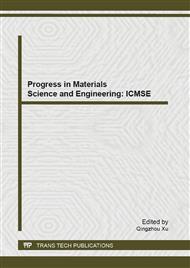[1]
Jintang Guo, Haichuan Lu, Shuoqiong Liu, Jianzhou Jin, Yongjin Yu, The Novel Fluid Loss Additive HTF-200C for Oil Field Cementing. Petrol. Explor. Develop. 39 (2012) 385-390.
DOI: 10.1016/s1876-3804(12)60055-x
Google Scholar
[2]
Yannick Mathieu, Avelino Corma, Michaël Echard, Marc Bories, Single and Combined Effects of Bottom Cracking (BCA) and Propylene Booster (PBA) Separate Particles Additives Addition to a Fluid Catalytic Cracking (FCC) Catalyst on the FCC Product Distribution and Quality. Applied Catalysis A: General. 439- 440 (2012).
DOI: 10.1016/j.apcata.2012.06.043
Google Scholar
[3]
Peter E. Clark, Analysis of Fluid Loss Data II: Models for Dynamic Fluid Loss. Journal of Petroleum Science and Engineering. 70 (2010) 191-197.
DOI: 10.1016/j.petrol.2009.11.010
Google Scholar
[4]
Caiyun Ji, Acrylic Acid-acrylamide Copolymer Fluid Loss Additive Preparation and Performance Evaluation. Journal of Yan'an Vocational & Technical Institute. 1674-6198(2012) 04-0113-02.
Google Scholar
[5]
Zhonghua Wang, Multiple Copolymer AMPS in the Application of the Drilling Fluid. Advances in Fine Petrochemicals. Vol. 1 No. 10.
Google Scholar
[6]
Xiaohua Yang, Xiaolin Qian, Lin Wang, Xianguang Wang, Xiaoqiang Dong: Development and Application of the High Temperature Resistant Polymer PFL-L as Fluid Loss Additive. Petroleum Drilling Techniques. 100-0890(2012) 06-0008-05.
Google Scholar
[7]
Jinku Xie, Xin Zhao, Jinchun Sheng, Xiang Guan, Synthesis and Properties of High Temperature-Resistant Starch Filtrate Reducer for Drilling Fluid. Petrochemical Technology. 1000-8144(2012) 12-1389-05.
Google Scholar
[8]
Yang Zhiyuan, Gong Liang, Ran PanPreparation of nitric humic acid by catalytic oxidation from Guizhou coal with catalysts. International Journal of Mining Science and Technology. 22 (2012) 75-78.
DOI: 10.1016/j.ijmst.2011.06.006
Google Scholar
[9]
Elham Mohammed M. Khair, Shicheng Zhang, Shanbo Mou, Mei Zhang, Performance and Application of New Anionic D3F-AS05 Viscoelastic Fracturing Fluid. Journal of Petroleum Science and Engineering. 78 (2011) 131-138.
DOI: 10.1016/j.petrol.2011.05.011
Google Scholar
[10]
Wan Tao, Yao Jie, Zishun Sun, Li Wang, Juan Wang, Solution and Drilling Fluid Properties of Water Soluble AM- AA- SSS Copolymers by Inverse Micro Emulsion. Journal of Petroleum Science and Engineering. 78 (2011) 334-337.
DOI: 10.1016/j.petrol.2011.06.027
Google Scholar
[11]
Philippe Nghe, Patrick Tabeling, Armand Ajdari, Flow-induced polymer degradation probed by a high throughput microfluidic set-up. J. Non-Newtonian Fluid Mech. 165 (2010) 313-322.
DOI: 10.1016/j.jnnfm.2010.01.006
Google Scholar
[12]
Md. Amanullah, Long Yu, Environment friendly fluid loss additives to protect the marine environment from the detrimental effect of mud additives. Journal of Petroleum Science and Engineering. 48 (2005) 199-208.
DOI: 10.1016/j.petrol.2005.06.013
Google Scholar


